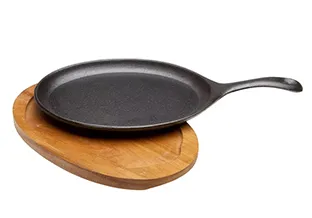
Versatile Cooking with an Oval Cast Iron Pot for Delicious Meals Every Day
The Timeless Appeal of the Oval Cast Iron Pot
In the world of culinary arts, few tools are as revered as the cast iron pot. Among the various shapes and styles available, the oval cast iron pot stands out for its unique design and versatility. This staple kitchen item has not only withstood the test of time but has also evolved to meet the needs of modern cooking. Let’s explore the charm and utility of the oval cast iron pot, and why it deserves a place in every kitchen.
A Brief History
Cast iron cookware dates back over two thousand years, with origins traced to ancient China. Its ability to retain heat and evenly distribute it made cast iron a preferred choice for cooking. The oval shape of the pot, while not the most common, offers advantages that enhance its functionality. Historically, it became particularly popular among European cooks for simmering stews and braising meats, as the design allows for more surface area, making cooking faster and more efficient.
Design and Construction
The oval cast iron pot is characterized by its elongated shape, which often accommodates larger cuts of meat or whole foods. Unlike round pots, the oval design allows for better organization of ingredients, making it easier to cook multiple items simultaneously. Typically, these pots come with a heavy lid that seals in moisture, ensuring that dishes remain succulent and flavorful.
Crafted from high-quality cast iron, these pots have superior heat-retention capabilities. They can withstand high temperatures, making them perfect for stovetop cooking and oven baking alike. Many modern oval cast iron pots are also enameled, which eliminates the need for seasoning and makes cleanup easier. The vibrant colors available not only add aesthetic value but also integrate seamlessly into kitchen decor.
Versatility in Cooking
One of the most significant advantages of the oval cast iron pot is its versatility. Whether you are sautéing vegetables, braising meats, or baking bread, this pot can handle it all. The shape is particularly conducive to preparing larger dishes, such as roasts or casseroles. Its deep design accommodates hearty sauces and stews, allowing for rich flavors to develop.
oval cast iron pot

In addition to traditional stovetop or oven use, many cast iron pots are suitable for campfires and outdoor cooking, making them a favored choice among outdoor enthusiasts. The durability of cast iron means that it can withstand extreme heat and can be used on grills and charcoal fires without compromising quality.
Maintenance and Care
Caring for an oval cast iron pot is straightforward but essential to ensure its longevity. If it is uncoated, seasoning the pot regularly will provide a natural, non-stick surface while preventing rust. After each use, it is advisable to clean it with hot water and a stiff brush, avoiding soap, which can strip away the seasoning. It is also important to dry the pot thoroughly to prevent moisture from causing corrosion.
For enameled versions, a gentle scrub with soap and water is sufficient for cleaning. However, abrasive cleaners and steel wool should be avoided to maintain the integrity of the enamel coating.
Culinary Heritage
Using an oval cast iron pot connects modern cooks with a rich culinary heritage. It represents a return to traditional cooking methods that prioritize flavor and quality. As home chefs seek to recreate family recipes and explore new cuisines, the cast iron pot serves as a reliable companion, bridging the gap between past and present.
Conclusion
The oval cast iron pot is more than just a cooking tool; it is a symbol of practicality and creativity in the kitchen. Its design, versatility, and durability make it an essential item for any cooking enthusiast. Whether you are preparing a simple family dinner or an elaborate feast, this iconic cookware can help elevate your culinary creations. By investing in an oval cast iron pot, you are not just acquiring a piece of cookware; you are embracing a timeless tradition that will serve you well for generations to come.
-
Season Cast Iron Perfectly with GPT-4 Turbo TipsNewsAug.01,2025
-
High Quality Cast Iron Cookware - Baixiang County Zhongda MachineryNewsAug.01,2025
-
Premium Cast Iron Pan: Durable & Perfect HeatNewsAug.01,2025
-
High Quality Kitchen Durable Black Round Cast Iron Cookware Pancake Crepe Pan-Baixiang County Zhongda Machinery Manufacturing Co., Ltd.NewsAug.01,2025
-
Cast Iron Cookware - Baixiang County Zhongda Machinery | Nonstick, Heat ResistanceNewsAug.01,2025
-
High Quality Kitchen Durable Black Round Cast Iron Cookware - Baixiang County Zhongda Machinery | Non-Stick, Heat Retention, DurableNewsJul.31,2025


